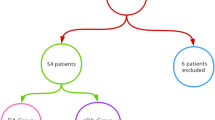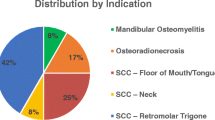Abstract
Purpose
To study a series of cases where vascularised fibula flap was used in various combinations of bone with muscle and skin along with its modifications for reconstruction of simple and composite defects of the facial region.
Patients and Methods
The investigators designed a retrospective study composed of patients with any pathology or defect who underwent reconstruction of maxilla or mandible with vascularised fibula free flap from 2009 to 2013. All patients were evaluated for age, gender, location and type of defect, incorporation of adjoining skin paddle and muscle, number of fibula osteotomies, ischaemia time, anticoagulant regimen, length of hospital stay, flap failure rate, dental implant rehabilitation. All patients with a minimum follow-up of 3 months post-operatively, were included in this study.
Results
The study sample composed of 30 patients with average age of 39.5 years. Immediate reconstruction was done in 86.66 % of patients. 93.1 % were mandibular reconstructions. In 40 % of patients, the fibula was double barrelled. Skin island was included with the fibula in 20 % of patients. 10 % patients underwent dental rehabilitation using implants with 6.66 % requiring distraction osteogenesis of the fibula which was not required with double barrel reconstructions. Hematoma at the recipient site was the commonest post-operative complication, although its frequency was low. A significant donor site morbidity of around 3.33 % was seen. Average stay in hospital was about 7 days. Post-operatively all patients ambulated normally and none used assisted devices. A reconstruction plate was used to achieve the ideal contour of the jaw in most cases. Aesthetic results were usually good, especially in young patients. The overall success rate was 93.33 %.
Conclusion
The fibula has many assets which make it the ideal choice for bony reconstruction of facial skeleton and adjoining soft tissue with predictable results.











Similar content being viewed by others
References
Taylor GI, Miller GD, Ham FJ (1975) The free vascularized bone graft. A clinical extension of microvascular techniques. Plast Reconstr Surg 55:533–544
Hidalgo DA (1989) Fibula free flap: a new method of mandible reconstruction. Plast Reconstr Surg 84:71–79
Chaine A, Pitak-Arnnop P, Dhanuthai K, Ruhin-Poncet B, Bertrand JC, Bertolus C (2009) A treatment algorithm for managing giant mandibular ameloblastoma: 5-year experiences in a Paris university hospital. Eur J Surg Oncol. doi:10.1016/j.ejso.2009.04.006
Hidalgo DA, Rekow A (1995) A review of 60 consecutive fibula free flap mandible reconstructions. Plast Reconstr Surg 96:585–596
Foster RD, Anthony JP, Sharma A, Pogrel MA (1999) Vascularized bone flaps versus nonvascularized bone grafts for mandibular reconstruction: an outcome analysis of primary bony union and endosseous implant success. Head Neck 21:66–71
Guerra MFM, Gías LN, Campo FJR, González FJD (2001) Vascularized free fibular flap for mandibular reconstruction: a report of 26 cases. J Oral Maxillofac Surg 59:140–144
Eckardt A, Fokas K (2003) Microsurgical reconstruction in the head and neck region: an 18-year experience with 500 consecutive cases. J Craniomaxillofac Surg 31:197–201
Klein S, Hage JJ, Woerdeman LA (2005) Donor-site necrosis following fibula free-flap transplantation: a report of three cases. Microsurgery 25:538–542
González-García R, Naval-Gías L, Rodríguez-Campo FJ, Muñoz-Guerra MF, Sastre-Pérez J (2008) Vascularized free fibular flap for the reconstruction of mandibular defects: clinical experience in 42 cases. Oral Surg Oral Med Oral Pathol Oral Radiol Endod 106:191–202
Jones NF, Vögelin E, Markowitz BL, Watson JP (2003) Reconstruction of composite through-and-through mandibular defects with a double-skin paddle fibular osteocutaneous flap. Plast Reconstr Surg 112:758–765
Jewer DD, Boyd JB, Manktelow RT, Zuker RM, Rosen IB, Gullane PJ et al (1989) Orofacial and mandibular reconstruction with the iliac crest free flap: a review of 60 cases and a new method of classification. Plast Reconstr Surg 84:391–403
Futran ND, Stack BC, Zaccardi MJ (1998) Preoperative color flow Doppler imaging for fibula free tissue transfers. Ann Vasc Surg 12(5):445–450
Gilbert A (1979) Vascularized transfer of the fibula shaft. Int J Microsurg 1:100–106
Frodel JL, Funk GF, Capper DT et al (1993) Osseointegrated implants: a comparative study of bone thickness in four vascularized bone flaps. Plast Reconstr Surg 92:449–458
Moscoso JF, Keller J, Genden E et al (1994) Vascularized bone flaps in oromandibular reconstruction. Arch Otolaryngol Head Neck Surg 120:36–43
Brown JS (1996) Deep circumflex iliac artery free flap with internal oblique muscle as a new method of immediate reconstruction of maxillectomy defect. Head Neck 18:412–421
Brown JS, Rogers SN, McNally DN, Boyle M (2000) A modified classification for the maxillectomy defect. Head Neck 1:17–26
Richardson D, Fisher SE, Vaughan DE, Brown JS (1997) Radial forearm flap donor site complications and morbidity: a prospective study. Plast Reconstr Surg 99:109–115
Author information
Authors and Affiliations
Corresponding author
Ethics declarations
Conflict of interest
All the authors declare that they have no conflict of interest.
Ethical Approval
All procedures performed in this study involving human participants were in accordance with the ethical standards of the institutional and/or national research committee and with the 1964 Helsinki declaration and its later amendments or comparable ethical standards.
Human and Animal Rights
This article does not contain any studies with animals performed by any of the authors.
Informed Consent
Informed consent was obtained from all individual participants included in the study.
Rights and permissions
About this article
Cite this article
Shroff, S.S., Nair, S., Shah, A. et al. Versatility of Fibula Free Flap in Reconstruction of Facial Defects: A Center Study. J. Maxillofac. Oral Surg. 16, 101–107 (2017). https://doi.org/10.1007/s12663-016-0930-6
Received:
Accepted:
Published:
Issue Date:
DOI: https://doi.org/10.1007/s12663-016-0930-6




